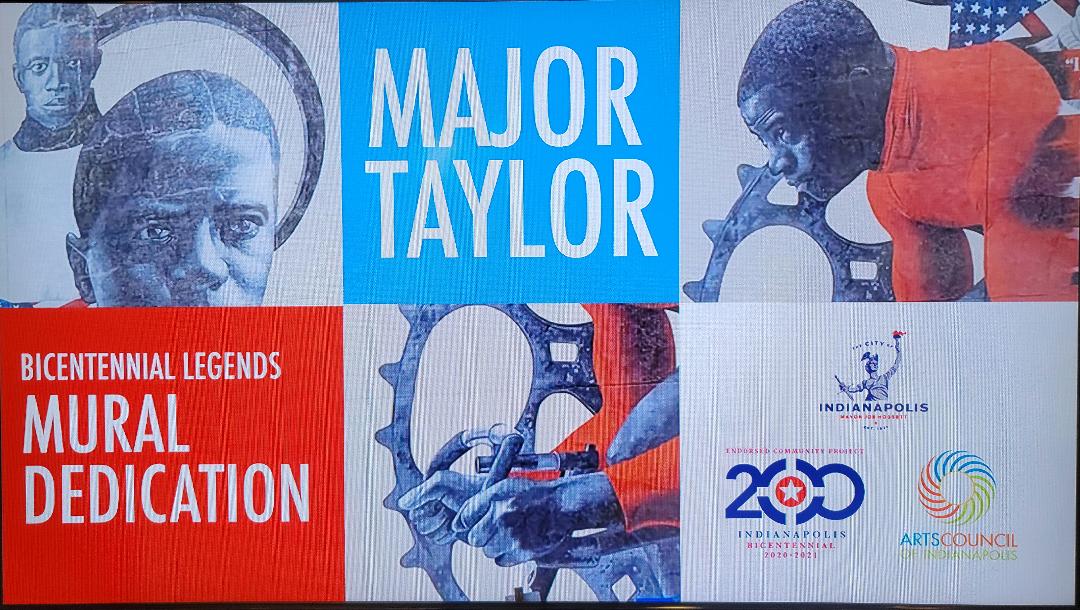A mural honoring the life of cycling champion Marshall “Major” Taylor was unveiled Thursday. The mural is the first in a series of future murals in the City of Indianapolis titled, “Bicentennial Legends”. The five-story mural is located on the backside of the Barnes & Thornburg building on the corner of Washington and Meridian streets in downtown Indianapolis. The mural is near the site where Major Taylor worked at a bike shop as a teenager.

“I wanted to leave a lasting impression on the residents of Indianapolis and visitors. Before the project, I admittedly had very little knowledge of his life and accomplishments as an athlete and activist. His legacy as a cyclist and pioneer is a worthy and esteemed honor, says Warren.”
Anthony Bridgeman and Dan Lee of the Major Taylor Coalition initiated the idea for the mural. The coalition raised $10,000 in public donations, and SRAM Corporation, a Chicago-based company, matched the total amount of public contribution raised. Additional funding was provided by Barnes & Thornburg LLP, The Bicentennial Commission, Glick Philanthropies, and the CIBA Foundation, Inc.
Held at Barnes & Thornburg, LLC., the private event included friends, family, and supporters who gathered to celebrate the first mural in the Bicentennial Legends Project series. Professional cyclists were in attendance, including Rashaan Bahati and the first HBCU cycling team, Saint Augustine University. Pro cyclist Justin Williams, the co-founder of the cycling team, L39ION of Los Angeles, spoke at the dedication. “I started my career on a Major Taylor-affiliated cycling club. He was my standard. I wore his silhouette every time I went to the line,” says Williams.”
Nelson Vails, the first African American to win an Olympic medal in cycling, said it was vital for him to attend the dedication. “This is a historical event. To see the mural erected and the ribbon cutting, it is truly an honor to be here,” says Vails.
The Mayor of Indianapolis, Joe Hogsett, proclaimed September 9 2021 Marshall “Major” Taylor Day. Karen Brown-Donovan, the great-granddaughter of Major Taylor, came from Hawaii to attend the dedication. “My great-grandfather dealt with discrimination and adversity. His life was an uphill battle against the odds. Yet, he looked into his own words from his autobiography, “Life is too short for any man to hold bitterness in his heart.” Major would have been delighted and slightly humbled of the mural, says Brown-Donovan.
Kelsey Elaine Johnson, an actor, writer, and educator from Indianapolis, closed the dedication with a poem entitled “From the Earth to the Stars,” inspired by the life and legacy of the legendary cyclist. Major Taylor Cycling Club Chicago (MTC3), founded in 2008, is dedicated to safe and enjoyable cycling in the Chicagoland area while educating about the legacy of Major Taylor. In August, the club celebrated the 122nd anniversary of Major Taylor winning the world 1-mile championship in Montreal, Canada.
Jason Ward, club president, says it’s essential that MTC3 maintain the vision of Major Taylor and family values. What we are doing is in line with what Major Taylor, himself, would have wanted. If he were alive today, he would enjoy what is currently happening. Our motto is “Make the Major proud!”
Marshall “Major” Taylor was born November 26, 1878, in Indianapolis, IN. Taylor worked at a bicycle shop where he earned the nickname “Major” due to wearing a military uniform. Taylor set numerous cycling records, including becoming a world cycling champion in 1899 and an American sprint champion in 1900. However, being a champion did not prevent Taylor from being exposed to racism and segregation.
In 1910, Taylor retired from cycling at age 32. In his retirement, he wrote his autobiography, “The Fastest Bicycle Rider in the World.” Taylor was involved in a few business ventures but was unsuccessful. In 1930, impoverished and estranged from his wife, Taylor moved to Chicago into a YMCA. Taylor died June 21, 1932, at the age of 53 and is buried at Mount Glenwood Memory Gardens South in Glenwood, IL. Major Taylor is recognized in Chicago with a mural on a pedestrian bridge over the Little Calumet River by artist Bernard Williams. The Major Taylor Trail stretches from 81st Street on the north end to 134th Street on the south end.
To learn more about Major Taylor Cycling Club Chicago, go to https://www.majortaylorchicago.com/, and the Friends of Major Trail go to http://www.majortaylortrail.org/FOMTT_1.0/index.htm.
Tammy Gibson is a black history traveler and author. Find her on social media @SankofaTravelher.
